Ira Aldridge
Ira Frederick Aldridge (July 24, 1807 – August 7, 1867) was an American and later British stage actor and playwright who made his career after 1824 largely on the London stage and in Europe, especially in Shakespearean roles. Born in New York City, Aldridge is the only actor of African-American descent among the 33 actors of the English stage honoured with bronze plaques at the Shakespeare Memorial Theatre at Stratford-upon-Avon. He was especially popular in Prussia and Russia, where he received top honors from heads of state. At the time of his sudden death, while on tour in Poland, he was arranging a triumphant return to America, with a planned 100-show tour to the United States.
Ira Aldridge | |
|---|---|
 Portrait of Aldridge by James Northcote | |
| Born | July 24, 1807 |
| Died | August 7, 1867 (aged 60) |
| Occupation | Actor |
| Years active | early 1820s–1867 |
| Spouse(s) | Margaret Gill, Amanda von Brandt |
| Children | Amanda, Ira, Luranah, Rachael |
He was married twice, once to an Englishwoman, once to a Swedish woman, and had a family in England. Two of his daughters became professional opera singers.
Early life and career
Aldridge was born in New York City to Reverend Daniel and Luranah (also spelled Lurona) Aldridge on July 24, 1807. At the age of 13, Aldridge went to the African Free School in New York City, established by the New York Manumission Society for the children of free black people and slaves. They were given a classical education, with the study of English grammar, writing, mathematics, geography, and astronomy.[1] His classmates at the African free school included Charles L. Reason, George T. Downing, and Henry Highland Garnet.[2] His early exposure to theater included viewing plays from the high balcony of the Park Theatre, New York's leading theater of the time, and seeing productions of Shakespeare's plays at the African Grove Theatre.
Aldridge's first professional acting experience was in the early 1820s with the African Company, a group founded and managed by William Henry Brown and James Hewlett. In 1821, the group built the African Grove Theatre, the first resident African-American theatre in the United States.[3] The short-lived company was the subject of protests by neighbors, thuggery attacks by a competitor, and racist parody by the Sheriff of New York who was also a newspaper publisher, making it clear that Aldridge's career prospects in America were dim.[4] Aldridge made his acting debut as Rolla, a Peruvian character in Richard Brinsley Sheridan's Pizarro. He may have also played the male lead in Romeo and Juliet, as reported later in an 1860 memoir by his schoolfellow, Dr. James McCune Smith.[5]
Confronted with the persistent discrimination which black actors had to endure in the United States, Aldridge emigrated to Liverpool, England, in 1824 with actor James Wallack. During this time the Industrial Revolution had begun, bringing about radical economic change that helped expand the development of theatres.[5] The British Parliament had already outlawed the slave trade and was moving toward abolishing slavery in the British colonies, which increased the prospect of black actors being able to perform.[6]
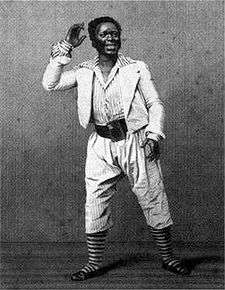
Having limited onstage experience and lacking name recognition, Aldridge concocted a story of his African lineage, claiming to have descended from the Fulani princely line.[3] By 1831,[7] he for a time took the name of Keene, a homonym for the then popular British actor, Edmund Kean. Aldridge observed a common theatrical practice of assuming an identical or similar nomenclature to that of a celebrity in order to garner attention. In addition to being called F. W. Keene Aldridge, he would later be called African Roscius, after the famous Roman actor of the first century BCE.[6]
At 17, Aldridge first appeared on the London stage in May 1825 in a low profile production of Othello.[4] On October 10, 1825, Aldridge made a much more high profile debut at London's Royal Coburg Theatre, and became the first African-American actor to establish himself professionally in a foreign country. He played the lead role of Oroonoko in The Revolt of Surinam, or A Slave's Revenge; this play was an adaptation of Thomas Southerne's Oroonoko (itself adapted from Aphra Behn's original work).[5]
According to the scholar Shane White, English theatre audiences had heard of the African Theatre because of British actor and comedian Charles Mathews, which had the ironic effect of boosting Aldridge's profile.[8] In a forerunner of blackface entertainment, Mathews had recently produced a popular comedic lampoon of what he imagined the African Theater was like (he had never actually been).[4] Bernth Lindfors says:
[W]hen Aldridge starts appearing on the stage at the Royalty Theatre, he's just called a gentleman of color. But when he moves over to the Royal Coburg, he's advertised in the first playbill as the American Tragedian from the African Theater New York City. The second playbill refers to him as "The African Tragedian". So everybody goes to the theater expecting to laugh because this is the man they think Mathews saw in New York City.[6]
An innovation Aldridge introduced early in his career was a direct address to the audience on the closing night of his engagement at a given theatre. Especially in the years leading up to the emancipation of all slaves in the British colonies in 1832, he would speak of the injustice of slavery and the passionate desire for freedom of those held in bondage.[3]
Critical reception

During Aldridge's seven-week engagement at the Royal Coburg, the young actor starred in five plays. He earned admiration from his audiences while most critics emphasized Aldridge's lack of stage training and experience. According to modern critics Errol Hill and James Vernon Hatch, early reviews were mixed. For The Times he was "baker-kneed and narrow-chested with lips so shaped that it is utterly impossible for him to pronounce English"; The Globe found his conception of Oroonoko to be very judicious and his enunciation distinct and sonorous; and The Drama described him as "tall and tolerably well proportioned with a weak voice that gabbles apace."[5] The Times critic also found fault with Aldridge's "copper" complexion, considering it insufficiently dark for Othello.[10]
Aldridge performed scenes from Othello that impressed reviewers. One critic wrote, "In Othello (Aldridge) delivers the most difficult passages with a degree of correctness that surprises the beholder."[11] He gradually progressed to larger roles; by 1825, he had top billing at London's Coburg Theatre as Oronoko in A Slave's Revenge, soon to be followed by the role of Gambia in The Slave, and the title role of Shakespeare's Othello. He also played major roles in plays such as The Castle Spectre and The Padlock. In search of new and suitable material, Aldridge also appeared occasionally as white European characters, for which he would be appropriately made up with greasepaint and wig. Examples of these are Captain Dirk Hatteraick and Bertram in Rev. R. C. Maturin's Bertram, the title role in Shakespeare's Richard III, and Shylock in The Merchant of Venice.
Aldridge's success also created enemies. The Athenaeum was scandalized by a black man with white actresses, and Figaro in London sought to "drive him from the stage" because of his color.[4]
Touring and later years
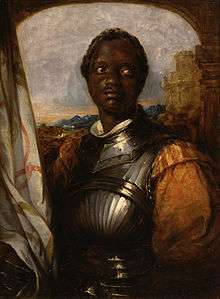
In 1831 Aldridge successfully played in Dublin; at several locations in southern Ireland, where he created a sensation in the small towns; as well as in Bath, England and Edinburgh, Scotland. The actor Edmund Kean praised his Othello; some took him to task for taking liberties with the text, while others attacked his race. Since he was an American black actor from the African Theatre, The Times called him the "African Roscius", after the famed actor of ancient Rome. Aldridge used this to his benefit and expanded African references in his biography that appeared in playbills,[6] also identifying his birthplace as "Africa" in his entry in the 1851 census.[12] In June 1844 he made appearances on stage in Exmouth (Devon, England).[13]
By at least 1833 he had added the anti-heroic role of Zanga in Edward Young's The Revenge to his repertoire.[14][15] The Revenge (1721) race-flips the plot of Othello by showing how Zanga, a captured Moorish prince who has become the servant and confidant of the noble Don Alonzo, vengefully tricks him into believing his wife is unfaithful. Alonzo finally kills himself and Zanga exults: "Let Europe and her pallid sons go weep; / Let Afric and her hundred thrones rejoice: / Oh, my dear countrymen, look down and see / How I bestride your prostrate conqueror!"[16]
An illustrated review of this performance[17] at the Surrey Theatre[18] shows Aldridge triumphing over Alonzo, dressed in flowing Moorish robes, which, according to the critic, "reminds one of the portraits of Abd-el Kader". The same reviewer praised Aldridge's comic talents in the contrasting role of Mungo (in the Bickerstaffe farce The Padlock), describing them as a refreshing corrective to current stereotypical "blackface" representation, "...differing entirely from the Ethiopian absurdities we have been taught to look upon as correct portraitures; his total abandon is very amusing."[18]
Aldridge first toured to continental Europe in 1852, with successes in Germany, where he was presented to the Duchess of Saxe-Coburg-Gotha, and performed for Frederick William IV of Prussia; he also performed in Budapest. An 1858 tour took him to Serbia and to Imperial Russia, where he became acquainted with Count Fyodor Tolstoy, Mikhail Shchepkin and the Ukrainian poet and artist Taras Shevchenko, who did his portrait in pastel.
Now of an appropriate age, about this time, he played the title role of King Lear (in England) for the first time. He purchased some property in England,[19] toured Russia again (1862), and applied for British citizenship (1863). Shortly before his death he was apparently ready to return to America to perform. It was reported that Aldridge had negotiated a 100-show-tour throughout the post-Civil War United States[4] In its obituary of Aldridge, The New York Times stated he had been booked to appear in the city's Academy of Music in September, but "Death has prevented the fulfilment of his intention".[20]
Marriage and family
.jpg)
Soon after going to England, in 1824 Aldridge married Margaret Gill, an English woman. They were married for 40 years until her death in 1864.
Aldridge's first son, Ira Daniel, was born in May 1847. The identity of his mother is unknown, but it could not have been Margaret Aldridge, who was 49 years old and had been in ill health for years. She raised Ira Daniel as her own; they shared a loving relationship until her death. He emigrated to Australia in February 1867.
Aldridge bought 5 Hamlet Road, in the prosperous suburbs of Upper Norwood, London, in 1861–2 shortly before becoming a naturalised British citizen in 1863. It was where his wife, Margaret, and later his second wife, Amanda, brought up his children. He named the house ‘Luranah Villa’ in memory of his mother. It now bears his English Heritage blue plaque.[19]
A year after Margaret's death, on April 20, 1865, Aldridge married his mistress, the self-styled Swedish countess Amanda von Brandt (1834-1915). They had four children: Irene Luranah,[21] Ira Frederick and Amanda Aldridge, who all went on to musical careers, the two girls as opera singers. Their daughter Rachael Frederica was born shortly after Aldridge's death and died in infancy. Brandt died in 1915 and is buried at Highgate Woods, London.
Aldridge spent most of his final years with his family in Russia and continental Europe, interspersed with occasional visits to England. He planned to return to the post-Civil-War United States, but he died in August 1867 while visiting Łódź, Poland.[22]
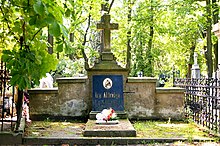
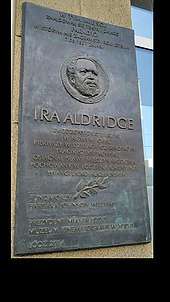
His remains were buried in the city's Old Evangelical Cemetery; 23 years passed before a proper tombstone was erected. His grave is tended by the Society of Polish Artists of Film and Theatre.
Plaque unveiled around June-July 2014, on the wall of the tenement house at ul. Piotrkowska 175, in the place where he died (at that time the "Paradyz" inn operated here). The plaque was created by the famous Polish sculptor - Marian Konieczny, and the founders were the president of Łódź/Lodz, the Cinematography Museum in Łódź/Lodz and Barbara Johnson-Williams, a researcher of the history of Aldridge. The unveiling of the plaque was also attended by Prof. Krystyna Kujawińska-Courtney from the University of Lodz, author of the book "Ira Aldridge (1807-1867). The History of the First Black Shakespearean Tragic"
A half-length portrait of 1826 by James Northcote shows Aldridge dressed for the role of Othello, but in a relatively undramatic portrait pose, is on display at the Manchester Art Gallery (in the Manchester section). Aldridge performed in the city many times.[24] A blue plaque unveiled in 2007 commemorates Aldridge at 5 Hamlet Road in Upper Norwood, London.[19] The plaque describes him as the "African Roscius".[19]
The case of Stothard v. Aldridge
In 1856 Aldridge was successfully sued by actor William Stothard,[25] who alleged Aldridge had had an affair with his wife Emma[26] three years before, resulting in the birth of a son.[27] (Under English law[28] of the time the husband of an adulterous wife was entitled to sue her lover for compensation.) At a hearing on January 14 in London before Mr. Justice Erle the jury found for the plaintiff Stothard, but in view of mitigating circumstances awarded him only £2 in damages.[29]
Aldridge was away on tour in Ireland when the trial took place[29] but he was heading the bill at a London theatre by the following year,[30] indicating the scandal caused his career no lasting damage.
Ira Aldridge Troupe
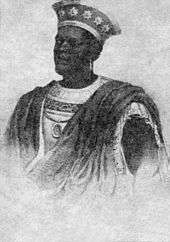
Aldridge enjoyed enormous fame as a tragic actor during his lifetime, but after his death, he was soon forgotten [in Europe]. The news of Ira Aldridge's death in Poland and the record of his achievement as an actor reached the American black community slowly.[31] In African-American circles, Aldridge was a legendary figure. Many black actors viewed him as an inspirational model, so when his death was revealed, several amateur groups sought to honor his memory by adopting his name for their companies.[5]
Many troupes were being founded in various places around America. In the late nineteenth century Aldridge-titled troupes were established in Washington, DC, in Philadelphia, and in New Haven, their respective productions at the time being an adaptation of Kotzebue's Die Spanier in Peru by Sheridan as Pizarro in 1883, School by Thomas William Robertson in 1885, and George Melville Baker's Comrades in 1889.[5]
The most prominent troupe named for him was the Ira Aldridge Troupe in Philadelphia, founded in 1863, some 35 years after Aldridge left the US for good.[32] The Ira Aldridge Troupe was a minstrelsy group that caricatured Irish white men. The Ira Aldridge Troupe is unique in annals of minstrelsy; it was named for a Black actor who had left his homeland some 35 years before and achieved fame in Europe. Unlike most, later, Black minstrel companies, the Aldridge Troupe apparently did not do plantation material, although they were billed as a 'contraband troupe'—that is, fugitive slaves. Perhaps because of their substantially Black audience, the troupe felt no need to "put on the mask." Although much of the material the group performed was standard fare, several of the company's acts were downright subversive.[32]
The Ira Aldridge Troupe appearing during the American Civil War made it "unique in the annals of minstrelsy." The Clipper (New York City) thought it was important enough to review; and it performed before a mixed audience, at a time when often white and black audiences were separated. Third, it was a black troupe presenting a program designed to appeal to their black audience. The Ira Aldridge Troupe performances eschewed the southern genre of old "darkies" longing for the plantation. The exclusion of southern nostalgia may have been in deference to a majority-black audience. The New York Clipper reported them as "A more incorrigible set of cusses we never saw; they beat our Bowery gods all to pieces."[5]
The troupe also created performances and songs that referred to the continuing Civil War. A ballad, "When the Cruel War is Over", became well known; it was performed by three members of the troupe—Miss S. Burton, Miss R. Clark, and Mr. C. Nixon. The song sold over a million copies of sheet music and was one of the most popular sentimental songs of the Civil War.[32] The song describes a soldier's farewell to his lady, the wounds he receives in battle, and his dying request for a last caress. The song, highly popular with white minstrel groups, was an example of the change in white minstrelsy that had been occurring at this time.[32])
Another popular production was a farce called The Irishman and the Stranger, with a Mr. Brown playing a character called Pat O'Callahan and a Mr. Jones playing the Stranger. This farce displayed black actors in white face speaking in a "nigger accent". The Clipper reporter referred to the performance as a "truly laughable affair, the 'Irish nagur' mixing up a rich Irish brogue promiscuously with the sweet nigger accent".[32] Perhaps the Aldridge Troupe's audience got its biggest satisfaction, however, from the role reversal inherent in the piece: since the beginning of minstrelsy, minstrels of Irish heritage, such as Dan Bryant and Richard Hooley, had been caricaturing Black men—now it was the turn of Black men to caricature the Irish.[32]
The history of minstrelsy also shows the cross-cultural influences, with Whites adopting elements of Black culture. The Ira Aldridge Troupe tried to pirate that piracy, and, in collaboration with its audience, turn minstrelsy to its own ends.[32]
Aldridge family
- Ira Daniel Aldridge, 1847–?. Teacher. Migrated to Australia in 1867.
- Irene Luranah Pauline Aldridge, 1860–1932. Opera singer.
- Ira Frederick Olaff Aldridge, 1862–1886.[33] Musician and composer.
- Amanda Christina Elizabeth Aldridge (Amanda Ira Aldridge), 1866–1956. Opera singer, teacher and composer under name of Montague Ring.
- Rachael Margaret Frederika Aldridge, 1867, died in infancy.
Legacy and honors
- Aldridge received awards for his art from European heads of state and governments: the Prussian Gold Medal for Arts and Sciences from King Frederick William III, the Golden Cross of Leopold from the Czar of Russia, and the Maltese Cross from Bern, Switzerland.[34]
- Aldridge is the only African American to have a bronze plaque among the 33 actors honored at the Shakespeare Memorial Theatre at Stratford-upon-Avon.
- A bust of Ira Aldridge by Pietro Calvi sits in the foyer of the Theatre Royal Drury Lane in London.
- Aldridge's legacy inspired the dramatic writing of African-American playwright Henry Francis Downing,[35] who in the early 20th century became "probably the first person of African descent to have a play of his or her own written and published in Britain."[36]
- In 2002, scholar Molefi Kete Asante listed Ira Aldridge in his 100 Greatest African Americans.
- His life was the subject of a play, Red Velvet, by Lolita Chakrabarti and starring Adrian Lester, produced at the Tricycle Theatre in London in 2012.
- Howard University Department of Theatre Arts, a historically black university in Washington, DC, has a theatre named after Ira Aldridge.
- Aldridge's Othello has been highly influential in starting a series of respected performances by African Americans in Othello in the 1800s and early 1900s, which includes: John A. Arneaux, John Hewlett, and Paul Robeson.[37]
- A blue plaque in Aldridge's honor was erected at Coventry, England.[38]
- A blue plaque was erected in 2007 by English Heritage at 5 Hamlet Road, Upper Norwood, London SE19 2AP, London Borough of Bromley.[19]
The Black Doctor (1847)
The Black Doctor, originally written in French by Auguste Anicet-Bourgeois, was adapted by Aldridge for the English stage. The Black Doctor is a romantic play about Fabian, a bi-racial physician, and his patient Pauline, the daughter of a French aristocrat. The couple falls in love and marries in secret. Although the play depicts racial and family conflict, and ends with Fabian's death, Aldridge portrays his title character with dignity. Some plot points mirror Aldridge's own life, as he married a white Englishwoman.[39]
See also
References
- Nicholas M. Evans, "Ira Aldridge, Shakespeare and Minstrelsy", The American Transcendental Quarterly, 1 September 2002, carried at Goliath.
- Simmons, William J., and Henry McNeal Turner. Men of Mark: Eminent, Progressive and Rising. GM Rewell & Company, 1887. p657
- Nelson, E.S. (2004). In African American Dramatists: An A-to-Z Guide. Santa Barbara, CA: Greenwood.
- Ross, Alex (July 29, 2013). ""Othello's Daughter"". The New Yorker. Retrieved January 14, 2019.
- Hill, Errol G., and James Vernon Hatch. (2003). A History of African American Theatre. Cambridge University Press.
- Lindfors, Bernth (2007). Ira Aldridge in Europe: How Aldridge controlled his identity as the 'African Roscius' (Audio documentary). Shakespeare in American Life. Folger Shakespeare Library. Archived transcript. Archived from the original (MP3) on December 18, 2015. Retrieved October 15, 2010.
- "The Coburg Theatre (review)". The Times. London. October 11, 1825.
- White, Shane (2007). James Hewlett after the African Grove: Shutting down the African Grove Theater (Audio documentary). Shakespeare in American Life. Folger Shakespeare Library. Archived transcript. Archived from the original (MP3) on December 18, 2015. Retrieved October 15, 2010.
- In the mid 19th century, the African-American actor Ira Aldridge and the English playwright C.A. Somerset collaborated on a new version that transformed Aaron, a Moor and the lover of the barbarian queen Tamora, from villain to hero, subverting racial stereotype. Aldridge and Somerset cut out most of the carnage and interpolated at least one scene from a contemporary melodrama that Aldridge had also starred in. Aldridge’s opinion: “I will venture to say that there is not a play on the stage with a more powerful climax.” A Scottish critic praised Aldridge’s performance as Aaron as “remarkable for energy, tempered by dignity and discretion.” Soloski, Alexis (April 4, 2019). "Let It Bleed: The Perverse Influence of 'Titus Andronicus'". The New York Times. Retrieved April 15, 2019.
- The Times (London, England), 11 October 1825, p. 2.
- Herbert Marshall, Ira Aldridge: The African Tragedian,
- 1851 England, Wales and Scotland census, folio 446, p. 30. Aldridge is staying at a boarding house in Derby with his wife and son, and gives his occupation as "Tragedian'".
- "Exmouth. This pleasant watering place has during the last two days been enlivened by the performances of the 'African Roscius'. Numerous assemblies have on each night testified their approbation of his impersonation of Othello and Revenge." in Trewman's Exeter Flying Post, 26 June 1844 (issue no. 4103).
- Schomburg, Arthur Alfonso. "List showing the theatres and plays in various European cities where Ira Aldridge, the African Roscius, acted during the years 1827-1867". Harvard Library. Retrieved June 15, 2020.
- "A collection of playbills from Theatre Royal, Dublin 1830-1839 Collection Item". British Library. Theatre Royal, Dublin. Retrieved June 15, 2020.
- The Revenge: A Tragedy by Edward Young.
- "The Theatre", Black Presence, The National Archives.
- The Illustrated London News, 1 April 1848, p. 218.
- "Blue plaque: Aldridge, Ira (1807–1867)". English Heritage. Retrieved February 2, 2019.
- The New York Times, 12 August 1867: "Obituary: Ira Aldridge, the African Tragedian".
- "Shakespeare, Wagner, Aldridge". Alex Ross: The Rest Is Noise. Retrieved February 15, 2019.
- Simmons, William J., and Henry McNeal Turner. Men of Mark: Eminent, Progressive and Rising. GM Rewell & Company, 1887, pp. 733–739.
- On the wall of the tenement house at ul. Piotrkowska 175, in the place where he died (at that time the "Paradyz" inn operated here). The plaque was created by the famous Polish sculptor - Marian Konieczny, and the founders were the president of Łódź, the Cinematography Museum in Łódź and Barbara Johnson-Williams, a researcher of the history of Aldridge. The unveiling of the plaque was also attended by Prof. Krystyna Kujawińska-Courtney from the University of Lodz, author of the book Ira Aldridge (1807-1867). The History of the First Black Shakespearean Tragic. The text of the board: "This was where the theater and inn 'Paradyz' was located, in which Ira Aldrige passed away on 7 July 1867. He was born on 24 July 1807 in New York. The first Black Shakespearean tragedy in history. He achieved international fame. Buried in Łódź, at the Evangelical-Augsburg Cemetery. Founders: Barbara Johnson-Williams, President of Łódź, Cinematography Museum in Łódź. Łódź 2014."
- Manchester Art Gallery
- Lindfors, Bernth (2012). "The Lost Life of Ira Daniel Aldridge (Part 1)" (PDF). Text Matters. 2 (2): 197–198.
- Emma Iggulden m. William Stothard 15 August 1850: see England and Wales Marriages (1850), vol. 1, p. 344, line 5
- Darby, Nell (2017). Life on the Victorian Stage: Theatrical Gossip. PEN & SWORD HISTORY. p. 95. ISBN 9781473882430.
- crim con
- ’’The Times’’(London), 15 January 1856, p.9: Law Report
- "City of London Theatre - Great Triumph of the African tragedian, Mr Ira Aldridge, who will this evening perform Shylock..." ’’The Times’’(London), 14 October 1857, p.9
- Lindfors, Bernth. Ira Aldridge, the African Roscius. Rochester, New York: University of Rochester Press, 2007
- Shalom, Jack. "The Ira Aldridge Troupe: Early Black Minstrelsy in Philadelphia." African-American Review 28.4 (1994): 653–658
- http://www.elliswashingtonreport.com/the-musicologist/3/
- Douglas O. Barnett, "Ira Aldridge", Black Past, accessed 15 October 2010.
- Roberts, Brian (2012). "A London Legacy of Ira Aldridge: Henry Francis Downing and the Paratheatrical Poetics of Plot and Cast(e)". Modern Drama. 55 (3): 386–406. doi:10.3138/md.55.3.386.
- Chambers, Colin (2011). Black and Asian Theatre in Britain: A History. London: Routledge. p. 63.
- Newmark, Paige. Othello: New Critical Essays. Edited by Philip C. Kolin. London and New York: Routledge, 2002.
- "First black Shakespearean actor honoured". BBC. August 3, 2017. Retrieved February 1, 2019.
- Hatch, James V., and Ted Shine, eds. Black Theatre U.S.A.. The Free Press, 1996 [1974], p. 4.
Further reading
- Ira Aldridge 1807–1867. The Great Shakespearean Tragedian on the Bicentennial Anniversary of His Birth, Krystyna Kujawinska Courtney and Maria Lukowska (eds). Frankfurt am Main: Peter Lang, 2009.
- Krystyna Kujawinska Courtney, Ira Aldridge (1807–1867) (Dzieje pierwszego czarnoskorego tragika szekspirowskiego), Kraków: Universitas, 2009.
- Bernth Lindfors, "Aldridge in Europe", Shakespeare in American Life, Folger Shakespeare Library's public radio documentary
- Herbert Marshall, Further Research on Ira Aldridge, the Negro Tragedian, FRSA, Center for Soviet & East European Studies, Southern Illinois University.
- Herbert Marshall Collection of Ira Aldridge, Collection 139, Southern Illinois University Special Research Collection: Theatre, material which Marshall collected for his biography of Aldridge.
- Rzepka, Charles. Introduction: "Obi, Aldridge and Abolition", Romantic Circles Praxis Series.
- The Black Doctor, Black Drama Database, subscription only.
- Hatch, James V., and Ted Shine. Black Theatre USA: Plays by African Americans. New York: Free Press, 1996. Print.
- Kimmelman, Elaine. Dark Comet. Avon Books, 1982.
External links
| Wikimedia Commons has media related to Ira Aldridge. |
- Ira Aldridge: The African Roscius, ed. Bernth Lindfors, University of Rochester Press, Rochester, New York, 2007
- "Aldridge Collection" finding aid for Northwestern University Special Collections' Aldridge family archival collection
- George F. Bragg, "Biography of Ira Aldridge", Men of Maryland